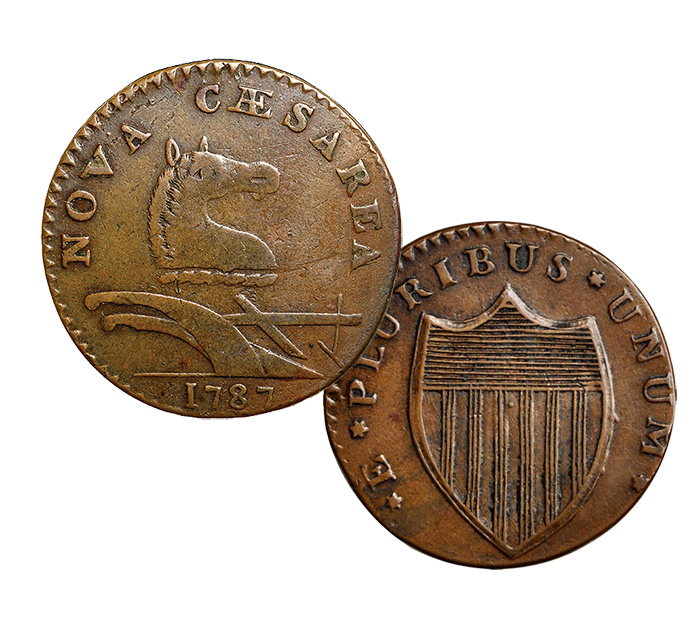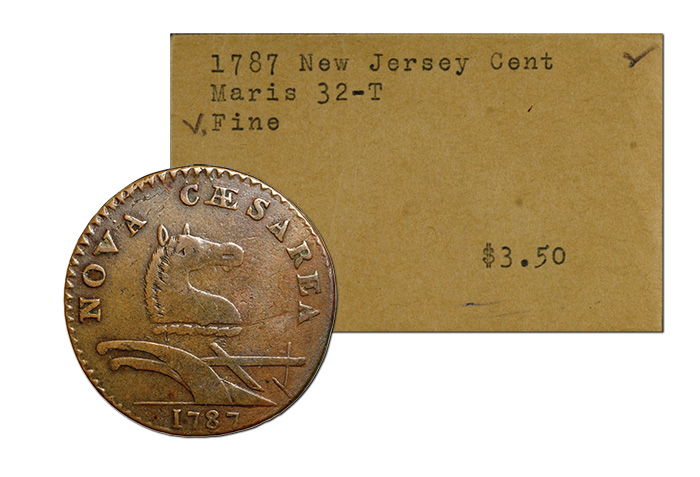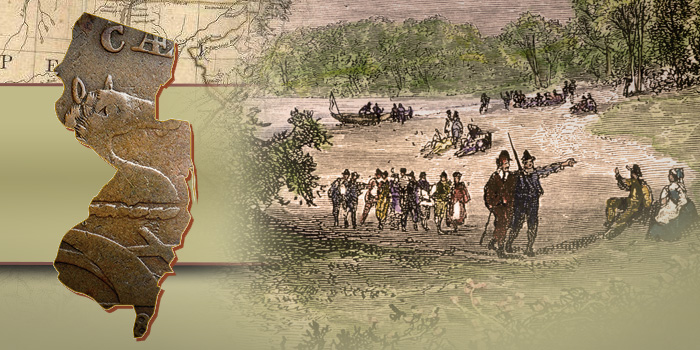Coin Rarities & Related Topics: News and Analysis regarding scarce coins, markets, and coin collecting #394
A Weekly Column by Greg Reynolds …..
Between the signing of the Declaration of Independence on July 4, 1776, and the enactment of the United States Constitution on June 21, 1788, the federal (national) government did not establish an official mint and it was legal for individual States to produce their own coins. Connecticut, Massachusetts, New Jersey and Vermont all took advantage of this fact and authorized official coinage. Therefore, my column for this week centers around the coins produced by the state of New Jersey during this period. It is easy to begin a meaningful collection of New Jersey Coppers.
Although historical aspects are introduced and emphasized, there is discussion of collecting New Jersey Coppers that currently cost from $300 to $3,000 USD each. Quite a few New Jersey Coppers with problems are available for less than $300.
For example, A non-gradable Curved Plow Beam 1786 New Jersey Copper, with the details of a Fine grade coin, sold for $92 in 2014. It was in a ‘PCGS Genuine’ holder.
New Jersey Coppers were minted from 1786 to 1788. Representatives of many varieties are available for less than $1,000 each. A set of most major varieties is not especially expensive in the context of 18th-century coins.
To understand New Jersey Coppers, there is a need to consider demand for copper coins in the 1780s. Gold coins did not circulate to a large extent in North America until the late 1830s. During the 18th century, colonists in the Americas and U.S. citizens after 1776 thought of silver coins as ‘money’, and other instruments as subsidiary to silver coins – including tokens, scrip, paper money and negotiable (tradable) fiscal paper of various kinds. Physical goods were often used in trade when government-issued money was not in the possession of the buyers.
While the silver coins of the Spanish Empire circulated widely in the Americas and the Caribbean since the 1500s, there was an ongoing shortage of copper coins. In the U.S., there were many transactions for goods valued below 6.25 cents (Half-Real) or even below 3.125 cents (Quarter-Real). Also, when people spent Reales (12.5 cent coins) or Two Reales (25 cent) coins, there was often a need to ‘make change’.
Eight Reales ≈ Silver Dollar ≈ Taler
For centuries, the Spanish Eight Reales coin (“Spanish Milled Dollar” or “Piece of Eight”) was the main monetary unit in most all of South America, Central America and North America. Furthermore, the U.S. silver dollar was based upon this coin. The Eight Reales denomination was both a coin and a common denominator. This unit stemmed from the Talers (or “Thalers”) of German speaking societies in Europe.
The first Talers were issued by the Count of Tyrol, Archduke Sigismund (1427-96). The geographical area that was then Tyrol now spans parts of Italy and Austria. These large silver coins were the inspiration for the Joachimthalers that emerged later in the 15th century.
For centuries, various German-speaking societies issued Talers, which were similar in size and silver content to the Eight Reales coins of the Spanish Empire. In 1551, the regime of King Edward VI of England issued five-shilling silver coins, called crowns, which were similar to Talers. Dutch ‘Lion Dollars’ (Leeuwendaalder) followed later.
German Talers, English five shilling coins, and Spanish Eight Reales coins (“Spanish Milled Dollars”) were the most important crowns. These circulated throughout the world in large quantities, and were imitated. Transactions requiring coins denominated below one-sixteenth, one-thirty-second or one-twelfth of a crown, however, were a hassle.
In theory, a Quarter-Real (1/32 = 3.125% of a Spanish Milled Dollar) was the smallest denomination. Although Quarter-Real coins were first minted in Mexico in the 1500s, they were rarely struck within the Spanish Empire until the 1790s. It would have been unusual for a Quarter-Real to be seen in North America in the 1780s, though larger denominations were sometimes literally sliced into parts to create smaller denominations. In practical terms, a Half-Real was the smallest silver denomination that was widely used and widely understood in the United States from 1776 until the 1800s.
During the 1700s, British silver coins did not circulate widely in North America. Although not always indicated in writings, business contracts or statutes, Spanish Milled Dollars (Eight Reales coins) were the money of North America. One Real was one-twelfth of a ‘dollar’ and a Half-Real silver coin was one-sixteenth (6.25 cents in current terminology).
British Halfpennies
British halfpennies each were worth 1/24 of a Shilling, according to British law. Various states, however, defined the term ‘shilling’ in ways that were different from the meaning of the term in the British monetary system where twelvepence equaled one shilling.
During various periods from the 1670s to the 1770s–though not consistently–copper halfpennies were minted in large quantities in England. They circulated widely, including in North America. Indeed, tens of thousands of them survive in the present.
Please read the recent discussion of imitation British halfpennies that were made in the State of New York. These circulated alongside genuine British halfpennies and were highly demanded for commerce. While patterns of New York Coppers were made, there was never an official New York coinage. There were not pertinent Spanish copper coins, at least none that circulated widely in North America.
Oddly, various states defined the term ‘shilling’ in ways that were different from the meaning of the term in the British monetary system where twelvepence equaled one shilling. In the U.S., individual states often used British monetary terms to refer to amounts in the Spanish Monetary system. Furthermore, before 1790, state legislatures played with definitions of the word ‘dollar’. A “dollar” in a particular state might be defined as ‘X’ Spanish Milled Dollars, where ‘X’ varied from state to state. A game of monetary semantics was beside the point that Spanish Eight Reales coins were the common denominator and there was a shortage of small change.
Why Were NJ Coppers Minted from 1786 to 1788?
As the shortage of small change had been ongoing for decades, why did production of Coppers in New Jersey, New York, Connecticut and Vermont span such a short time period, roughly from 1785 to 1789?
The answers relate to politics. The British had stopped producing halfpennies in the mid-1770s, and the number extant was insufficient in both Britain and the U.S. “During the period 1787 to 1797” in Great Britain, asserts Tony Clayton in his online book, “many private trade tokens were manufactured to fill the gap left by the absence of official small change.”
The Morris plan for a U.S. coinage system resulted in a few patterns in 1783, but was doomed. By the mid-1780s, it was apparent that coins for small change had to be produced by states or private firms as the national government was not to authorize coinage while the Articles of Confederation were the highest law of the land. ‘The Articles’ provided for a loose federation of independent states with a very weak national government.
 On May 29, 1790, Rhode Island was the last of the original 13 States to ratify the U.S. Constitution. As it was established at the Constitutional Convention that the Constitution would take effect if ratified by nine state legislatures, the U.S. Constitution became the highest law of the nation two years earlier, when the ninth state ratified it.
On May 29, 1790, Rhode Island was the last of the original 13 States to ratify the U.S. Constitution. As it was established at the Constitutional Convention that the Constitution would take effect if ratified by nine state legislatures, the U.S. Constitution became the highest law of the nation two years earlier, when the ninth state ratified it.
Although the predecessor of the U.S. Constitution, the Articles of Confederation allowed each state to produce its own coins, the U.S. Constitution explicitly prohibits state governments from minting coins or authorizing coinage. Importantly, ‘The Articles’ included more hurdles than the U.S. Constitution for a national coinage to begin.
In sum, dwindling quantities of British halfpennies, lack of Coppers from elsewhere, the reality that a U.S. Mint would not be established under the Articles of Confederation, and the enactment of the U.S. Constitution in 1788, altogether resulted in State and private Coppers being minted between 1785 and 1789.
Indisputably, New Jersey, Connecticut and Vermont Coppers widely circulated, often beyond the borders of their respective states. The values attached to them in a vast majority of pertinent transactions varied and are not now precisely known. It is generally believed that all such State Coppers tended to circulate at par with genuine British halfpennies and imitation British halfpennies. In many circumstances, values of Coppers were determined by the parties to the respective transaction, who were sometimes influenced by state law and local customs.
The Design
New Jersey Coppers depict a legend, Nova Caesarea, on the obverse. In this context, nova is Latin for ‘new’. According to Louis Jordan of the University of Notre Dame, the “use of “CÆSAREA” is based on the ancient classical name for the Island of Jersey in the English Channel. In Roman times this island was called Caesar’s Island (insula Caesarea) so when Latinizing the state name, the word Jersey was transformed to ‘Caesarea.’”
 On the obverse of each New Jersey Copper, there is a representation of the head of a horse and of a plow. Before the 20th century, the U.S. was largely agricultural.
On the obverse of each New Jersey Copper, there is a representation of the head of a horse and of a plow. Before the 20th century, the U.S. was largely agricultural.
Such a horse’s head and illustrations of three plows appear on the Coat of Arms of New Jersey, which was adopted in 1777. On New Jersey Coppers, the reverse depicts a shield, somewhat similar to shields that would later be found in designs for U.S. coins.
The designer of the New Jersey Coat of Arms, Pierre Eugene du Simitiere, was very much involved in the design of the Great Seal of the United States. He is credited with suggesting the national slogan, ‘E. Pluribus Unum’ (“Out of Many, One”), which appears on both the New Jersey Coat of Arms and the Great Seal of the United States. The seal did not become official until 1782.
 The motto of the State of New Jersey, however, is “Liberty & Prosperity”. It is curious that a national motto appears on state coinage, as people then tended to identify with their respective states to a much greater extent than people do now. During the late 1770s and ’80s, many U.S. citizens were fearful of the national government, and the Articles of Confederation severely limited the power of that government.
The motto of the State of New Jersey, however, is “Liberty & Prosperity”. It is curious that a national motto appears on state coinage, as people then tended to identify with their respective states to a much greater extent than people do now. During the late 1770s and ’80s, many U.S. citizens were fearful of the national government, and the Articles of Confederation severely limited the power of that government.
Practical & Inexpensive Collecting
There is no need to study history or philosophy to enjoy collecting New Jersey Coppers. The following is a list of major varieties that constitute a set that can be completed without spending a fortune:
- 1786 ‘No Coulter’
- 1786 Straight Plow Beam
- 1786 Curved Plow Beam
- 1787 Curved Plow Beam
- 1787 Straight Plow Beam
- 1787 Camel Head
- 1787 Deer Head
- 1787 Serpent Head
- 1787 Sprig Above Plow
- 1788 Head Right
- 1788 Fox on Reverse
- 1788 Head Left
Rather than itemize each of these 12 major varieties, just those from 1787 are discussed here. The 1787 varieties are the most interesting. Besides, 1786 and 1788 New Jersey Coppers are not generally more expensive than 1787 Coppers.
Records of auction or internet-only sales provide general ideas as to the costs of these. There are many variables that may affect any one sale, and none of the coins mentioned are being specifically recommended. It is important to carefully inspect coins.
There are several factors in addition to certified grades that affect the values of coins. Two coins that were struck from the same pair of dies and certified as the same grade by the same grading service may be extremely different in characteristics and value.
1787 Curved Beam
The beam on the plow is very much curved on many New Jersey Coppers and relatively straight on others. This is a readily noticeable distinction.
In November 2014, Heritage auctioned a substantial number of New Jersey Coppers from the Eric P. Newman Collection. An NGC-graded VF-25, 1787 Curved Plow Beam coin brought $432. There are many others of this major variety that could be purchased for less than $1,000 each.
1787 Straight Beam
The Straight Beam 1787 New Jersey Coppers are not as straight as the 1786 Straight Beam coins. The beams on these, however, are strait enough to distinguish them from 1787 Curved Beam varieties.
Early in November 2017, Heritage sold a 1787 Straight Beam New Jersey Copper that is in an NGC “AU Details” holder with a notation that this coin has “scratches”. While I have not seen the coin, the scratches do not seem to be all that bad. The price realized of $600 may be a good deal, from a logical perspective.
Also in November, Heritage auctioned a 1787 Straight Beam from the Eric Newman Collection for $1,175. It was NGC-graded VF-30.
1787 Camel Head
The Camel Head is one of the most popular varieties of New Jersey Coppers. The horse appears different than it does on other varieties and is somewhat reminiscent of a camel.
 Although dozens of Camel Head New Jersey Coppers have been auctioned for less than $1,000 (and some for less than $600), most of these have very noticeable problems of one sort or another. A really appealing ‘Camel Head’ New Jersey Copper is apt to cost more than $1,000.
Although dozens of Camel Head New Jersey Coppers have been auctioned for less than $1,000 (and some for less than $600), most of these have very noticeable problems of one sort or another. A really appealing ‘Camel Head’ New Jersey Copper is apt to cost more than $1,000.
In March 2017, Stack’s-Bowers auctioned a PCGS-graded AU-55 Camel Head for $2,115. In 2012, Stack’s-Bowers auctioned the exact same coin for $2,350. Like many New Jersey Coppers, it was overstruck on a Connecticut Copper.
1787 Deer Head
The Deer Head New Jersey Copper is not as famous as the Camel Head and is rarer. Low-grade representatives are not expensive. Any Deer Head that certainly grades EF-40 or higher would be likely to cost a great deal.
On November 3, 2017, Heritage auctioned an NGC-graded VF-20 Deer Head from the Eric Newman Collection. The $1,080 result was weak, perhaps a good deal for the buyer.
1787 Serpent Head
The Serpent Head is more distinctive and entertaining than either the Camel Head or the Deer Head. A VG to VF gradable Serpent Head could certainly be purchased for less than $1,500. Some of the pieces that have sold for less than $1,000, though, are notably problematic. It is a good idea to carefully inspect these with magnification.
In October 2017, Heritage sold a PCGS-graded Fine-15 Serpent Head for $336. There may be substantial corrosion on the reverse. If so, it is likely that bidders considered such corrosion when formulating their bids.
In March 2017, Stack’s-Bowers auctioned a PCGS-graded VF-35 Serpent Head for $1,997.50. In May 2014, an NGC-graded MS-63 Serpent Head from the Eric Newman Collection realized $20,562.50.
1787 Sprig Above Bow
There are many die pairings of this major variety where twigs appear above the plow and below the horse. In November 2016, Stack’s-Bowers auctioned a PCGS-graded Fine-15 ‘Sprig Above Plow’ 1787 for $399.50. A year later, the same firm auctioned a different PCGS-graded Fine-15 ‘Sprig Above Plow’ 1787 for $504.
In April 2014, Heritage sold a damaged coin with in a “VG DETAILS” NGC holder for $95.18. This was a good deal. The twigs are fairly clear as is a considerable amount of detail on the obverse.

In November 2014, Heritage auctioned a coin of this major variety from the Eric Newman Collection. That ‘Sprig Above Plow’ 1787 was NGC-graded VF-20 and realized $1,080. It is another New Jersey Copper that was struck over a Connecticut Copper.
Commentary & Advice
There are varieties listed in some price guides that are being ignored here. The ‘narrow shield’ and ‘wide shield’ categorizations are misleading, as the shape and size of the shield varies considerably. Two ‘wide shield’ varieties may appear very different from each other. Also, many New Jersey Coppers feature shields of medium width.
There are multiple varieties of 1787 New Jersey Coppers that relate to misspellings of ‘E. Pluribus Unum’, some of which are subtle. It is best to leave these for specialists in die pairings (many collectors ignore them).
The varieties that relate to die breaks, die rust or re-engravings on dies are not major varieties. Indeed, these are die states, products of different periods in the lives of individual dies. These should be addressed by collectors who are interested in all the die pairings.
The 12 major varieties that I listed are central to a logical and understandable strategy for collecting New Jersey Coppers. Importantly, such a ‘set’ of 12 may be completed in a reasonable amount of time at a reasonable cost, perhaps in a few months.
In contrast, collecting New Jersey Coppers by die pairing or die state may require decades. Before embarking upon such a quest, it makes sense to complete the set of 12 that I suggest. After fulfilling such an objective, a collector may further collect New Jersey Coppers or, more likely, will turn to other series.
There are many cool pre-1793 U.S.-related items to pursue. Additionally, Latin American coins of the 19th century tend to be historically important and much less expensive than analogous U.S. coins. Also, market values for U.S. Liberty Seated coins have fallen well below their all-time highs.
© 2017 Greg Reynolds





